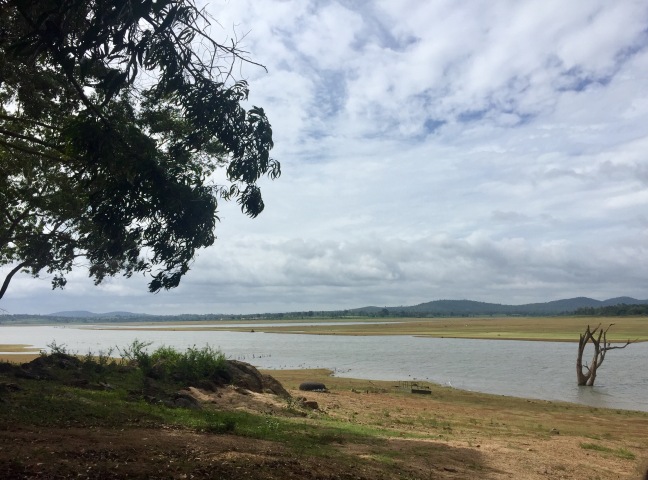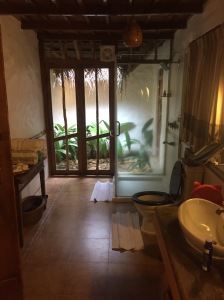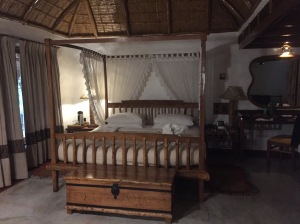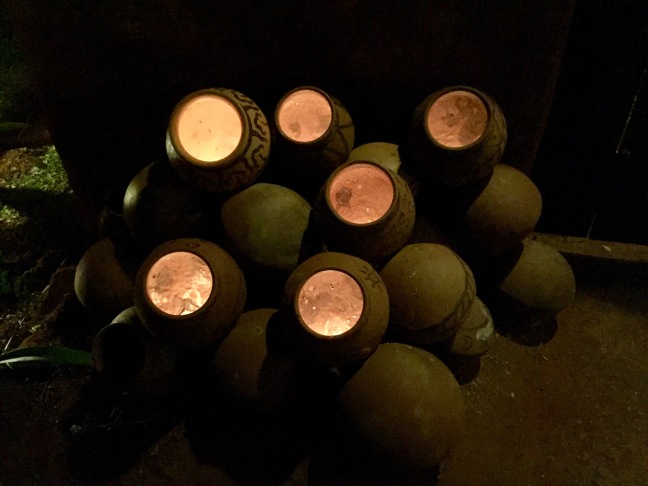
.
The Kabini River is surrounded by stunning landscapes, forests, wildlife and birds. It is tranquil (eerily quiet after the constant noise of Bangalore) and beautiful. We watched the sun set over the hills from our villa listening to the monsoon rain lashing into the river and were woken by the sound of the dawn chorus from the huge variety of birds. It was idyllic. I could have stayed a lot longer.
The journey
The Kabini lake is a large forest lined reservoir about 70km south of Mysore. The guide book indicated it was a 5 hour drive from Bangalore along the state highway 17 ( the main road between Mysore and Bangalore) then state highway 33 from Mysore to Mananthavady before winding through local villages to get to Kabini itself.
We left on Saturday morning for our weekend away. We usually leave on Friday evening and do part of the journey then to break up the travel. However we had a leaving party to go to on the Friday evening so travel was out of the question. It turned out to be a good decision. The roads to Kabini are best described as variable; some have tarmac (in various degrees of repair) whilst others are merely mud and rock. This was the only road to our destination and frequently goats, cows and dogs blocked the road. There were no street lights and it was across winding roads through farmland. I can’t think how anyone can make that route safely at night; it was difficult enough during the daytime.
It wasn’t helped by me being sick at the roadside part way through the journey. As I don’t usually get car sick I assume it was the revenge of Bangalore Belly. Toilet stops are rare on the highway (never mind the village roads) so I had the indignity of being watched by intrigued locals as I emptied my stomach for all to see. I’m so glad we carry water and tissues with us everywhere.
We arrived at our destination 6 hours after we had departed Bangalore. Not a bad journey time but difficult nonetheless. The road to the hotel was pretty much off roading which is surprising when you’re going to an expensive place.
The Hotel
As we pulled in to the complex staff were ready to greet us (having called on our way asking for our estimated time of arrival). We were greeted by a tribal flute player and being adorned with the traditional red bindi on the middle of the forehead. We were ushered into the arrivals lounge and check in was swift and easy. We were offered sugar cane juice as we gazed out of the lounge looking over the Kabini. It was so quiet.
Various staff members introduced themselves and what the hotel had to offer. We were assigned a specific staff member whose responsibility it was to take care of all of our needs during our stay. Nothing would be too much trouble. We were handed an envelope detailing activities, timings and were applicable charges. We asked immediately to be booked onto a Safari for the following day, having been advised that places are limited and book up quickly. The naturalist looked crest fallen as he advised me that it might not be possible but he would do his best. (He managed it by dinner).
Our assigned staff member then walked us through the complex and pointed out various places and activity points on the way. We arrived at our pool villa which overlooked the Kabini and were shown its features. The mini bar was complimentary (soft drinks and snacks) and would be relensihed daily. There was a snack box and fruit bowl. Anything we specifically wanted would be provided. Zahra immediately asked for some Mysore Pak (a plate was provided) and I asked for some more tea (also provided). Really nothing was too much trouble. The chefs took pleasure in providing specific dairy free meals and desserts for me during our stay which made it great for me (as meals at hotels are usually difficult and I’m made to feel difficult for asking for dairy free).
The villa was so relaxing. We swam and rested by our private pool. We sat out watching the birds along the Kabini river as the sun set. It was quiet but for the sounds of wildlife.
The hotel has a spa, an infinity pool for adults and a children’s pool with slide and games area. None of which we used during our weekend stay – we simply didn’t have time. There was an information display informing of the animals, birds and insects surrounding the hotel. There was also a tribal hut and butterfly garden. We visited the reading room with its majestic views across the Kabini. We took in the stunning landscape whilst we rested awhile.
There were a series of activities planned for children including The Little Bartender, Plant a Sapling, Little Baker, Young Naturalist, Young Hotelier and Towel Artist. Zahra was content with the pool and didn’t want to participate. She was having a relaxing holiday too!
e








Tribal Dance Display
The Kadu Kurubas (“forest shepherds” in Kannada) are the original inhabitants of the forests of Nagarhole. They were originally hunter gatherers before switching to Swidden agriculture (slash and burn farming method), then collection of forest produce and basket weaving. They now work as small farmers around the forest.
The hotel, as part of its responsible tourism program, arranges displays from the local tribesmen of their celebratory dances. We were educated in three tribal dances and guests were encouraged to join in the last. We watched.
.
Wildlife Safari
Nagarhole National Park is home to some of the most endangered (and elusive!) species in the world. Nagarhole means “cobra river” in Kannada, so named as it snakes through the tropical forests. The Park was set up in 1955 and extended in 1974 when it was accorded National Park status and dammed for an irrigation project. The Park is home to the tiger, asiatic Elephant, leopard and a myriad of other wildlife species.
Nagarhole National Park strictly controls the tourist incursions and they are limited in number, times and areas of the park to reduce the impact on the wildlife. They exclusively manage the jeep safaris and allocate resorts in the area a specific number of seats. As a consequence the twice daily safaris fill up very quickly. They are 6:30am to 9:30am and 3pm to 6pm. We were allocated the early morning slot meaning a wake up call of 5:15am for a meet time of 5:45am to cross the river to get to the Nagarhole National Park by 6:30am. It was a tough get up. It was even tougher for a 10 year old who was basically walking asleep!
Our jeep was like a small bus with 17 tourists. It was a noisey diesel engine so any wildlife would hear us coming a long way off. The guide gave us all a pair of binoculars and told us to keep our cameras ready.
Spotted deer were everywhere in large and small herds. We saw a Sambar deer, which is the size of a small horse, but were unable to get a picture of the camera shy animal. The Malabar Giant Squirrel proved equally elusive to the camera as did the Gaur. Birds proved impossible to capture but I was pleased to spot a rare white bellied woodpecker. I was able to take some shots from my phone of some of the animals we saw. The elephant was particularly close and completely uninterested in our presence as he ate his breakfast.





Departure
Check out on the last day was as swift as check in. The chef had prepared a hearty packed lunch for us for our journey home. They took feedback seriously and strived for excellence. They called and messaged us later in the day to ensure we got home safely. Now that is what I call excellent service.
It was too short a holiday and a brief stay in idyllic surroundings. I would highly recommend a trip to Kabini and especially a stay at Orange County (and no, they haven’t paid me for this post – it’s a good old fashioned recommendation based on experience.)

